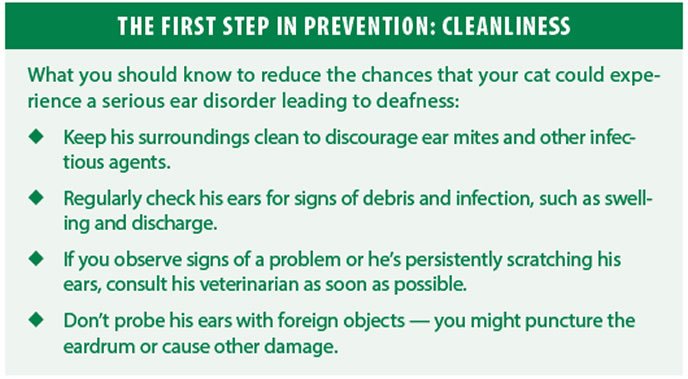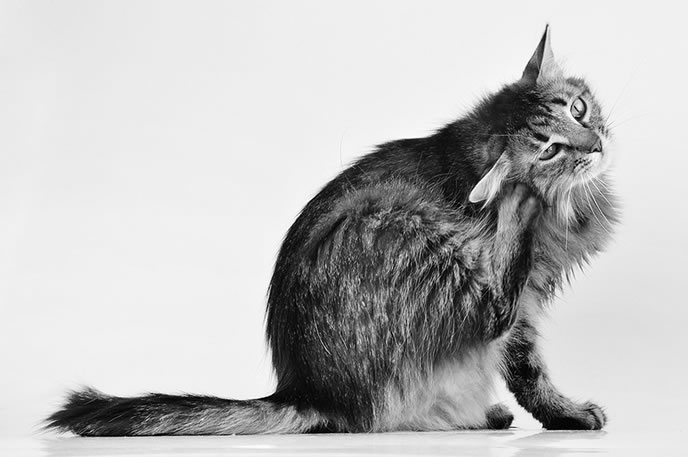
Bigstock
If your cat has become unresponsive to everyday sounds, squeaky toys or his name, if he doesnt know youre in the room unless you touch him, or if a loud noise fails to awaken him, a veterinary visit should be scheduled to determine if hes losing his hearing. Hearing is a vital sense for cats and greatly contributes to their self-preservation and comfort with us.
Deafness in cats can be caused by a wide variety of conditions. It can be temporary or permanent, complete or partial, acquired or inherited. Certain cats are at greater risk of hearing loss because of their breeds or lifestyles – outdoor cats, for example, are more prone to ear mites. The best line of defense for owners is to be educated about this complex condition.
Congenital Cases. The overall incidence of deafness in cats has not been determined. Some cats are deaf at birth, and this congenital disability cannot be corrected. White cats, in particular, are likely to suffer from inherited congenital deafness caused by a degeneration of the inner ear. Its estimated that between 20 and 50 percent of white cats are affected by at least partial deafness.
This figure rises to 80 percent in white cats with two blue eyes. Those at high risk include breeds with white coats: Persians, Scottish Folds, Ragdolls, Cornish Rexes and Devon Rexes, Oriental shorthairs, Turkish Angoras, Maine Coons and Manx.
The precise reason that white hair and blue eyes are strongly linked to deafness is not fully understood but it is thought to be related to the lack of melanocytes in these cats. Melanocytes produce melanin, the pigment primarily responsible for skin, hair and eye color.
Some white cats might be born deaf in only one ear. If a cat has one blue eye and is deaf in one ear, the eye and ear will invariably be on the same side of the head. Cats with one deaf ear might act normally to the extent that owners dont notice the problem.
Most of the current research in this area is reviewing the genetic or inherited forms of deafness, says Amanda Full, DVM, ACVIM, a former resident in neurology at the Cornell University Hospital for Animals, now at Chicago Premier Veterinary Group.
Discerning specific causes of hearing loss is a challenge. One difficulty is in studying the neuroanatomy – the anatomy of the nervous system – because the ear is difficult to preserve for post-mortem research.
Todays Focus. The primary focus today is on early recognition of hearing loss for owners and prevention by identifying genetically high-risk breeds and testing at a young age for breeders, Dr. Full says.
While deafness can be inherited in cats, most cases are acquired conditions. Among these, otitis externa (inflammation/infection of the external ear canal) is the most common. If left untreated, the infection can progress into the middle and inner ear.
Ear canals can become filled with any number of obstructions that can lead to infection, says dermatologist William H. Miller, Jr., VMD, Medical Director of the Cornell University Hospital for Animals. If the ear canal is filled with pus, wax or mite debris, sound waves dont reach the eardrum completely or at all, he says. This decreases the animals hearing to varying degrees. Some dont hear well, while others are deaf.
If ear debris is removed and the infection treated, a cats hearing can return. But when external ear canal disease becomes chronic, the eardrum can be breached. This can lead to inner ear disease, which usually will result in impaired hearing that can be permanent, Dr. Miller says.
Ear mites in kittens are often another problem. If those arent treated, they can persist forever, Dr. Miller says. Beyond that, ear polyps and allergies are recognized as fairly common causes of ear disease in the cat. In the grand scheme of feline health, however, he adds that the incidence of these conditions is relatively low.
In contrast to inherited congenital deafness, which usually becomes apparent in a cat only weeks after birth, acquired deafness usually develops over time as a result of ear canal disease. Sudden loss of hearing without pre-existing ear canal disease is rare in animals, Dr. Miller says. It can be associated with a drug the animal might be taking, but it can also be due to brain disease.
Drug Exposure. Ototoxicity – also known as ear poisoning – results from exposure to drugs or chemicals that damage the inner ear or the nerve that sends balance and hearing information from the inner ear to the brain. Certain antibiotics, ear cleaners, household chemicals and chemotherapy drugs can lead to ototoxicity in cats. These toxins might be ingested or seep into the inner ear through a perforated eardrum. Depending on the toxic agent that causes the hearing loss, some effects are reversible. The faster the hearing loss in a cat can be identified and addressed by a veterinarian, the better the prognosis.
Beyond infections and toxins, owners should also keep in mind that a cats eardrum thickens with age. Hearing difficulties and sometimes even deafness are often found in older cats regardless of whether their ears have been infected.

Deafness in cats can be difficult to detect when it develops gradually, as animals tend to adapt over time to compensate for hearing loss. When deafness follows ear canal disease, owners might also observe symptoms related to that disease, including head shaking, ear scratching and odor emanating from the ear.
Simple Diagnosis. If you suspect your cat might be deaf or experiencing difficulties hearing, you should immediately seek veterinary treatment. Diagnosis is relatively easy with a complete physical examination, Dr. Miller says. When there is middle ear disease or a suggestion of brain disease, special tests like a CT scan, MRI or brainstem auditory evoked response (BAER) test – which evaluates the brainstems electrical response to an auditory stimulus – may be indicated. These latter tests need to be done by a specialist.”

Bigstock
The BAER test, performed by neurologists, takes only 10 to 15 minutes and often provides definitive diagnosis. Ear plugs or headphones are placed over the cats head, and clicks or tones are delivered to the ears. Small electrodes placed under the skin measure the brains electrical response to the auditory stimulus.
No treatment is available for inherited congenital deafness. Most acquired feline ear disorders, including otitis externa, can be treated with medicine. The specific medicine and related cost will depend on the diagnosis.
In very chronic infections where the eardrum is totally destroyed, the hearing will be lost, Dr. Miller says. But most cases of external canal disease can be treated and a return to normal hearing can be expected. Again, the earlier ear disease is diagnosed, the better the outcome is likely to be.
Even in cases of permanent hearing loss that cannot be reversed, cats can use their other senses to compensate, and many continue to enjoy a good quality of life.



